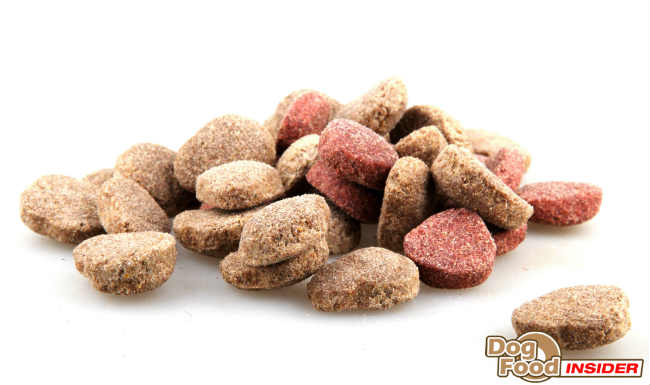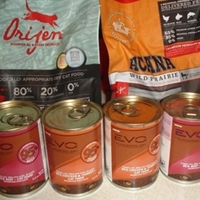
This post may contain affiliate links. We are compensated for referring customers to our affiliate partners.
 Canned and kibble dog food both have their good and bad points. Which food you decide to feed is really a personal decision based on many factors. There are plenty of good dog foods available in both kinds of food so don’t let someone tell you that you have to feed your dog one or the other if you care about your dog. Your choice will depend on the particular diet you’re feeding your dog, the size of your dog, how many dogs you have, and other factors. Here are some of the pros and cons for you to consider about canned and kibble dog food so you can make your decision.
Canned and kibble dog food both have their good and bad points. Which food you decide to feed is really a personal decision based on many factors. There are plenty of good dog foods available in both kinds of food so don’t let someone tell you that you have to feed your dog one or the other if you care about your dog. Your choice will depend on the particular diet you’re feeding your dog, the size of your dog, how many dogs you have, and other factors. Here are some of the pros and cons for you to consider about canned and kibble dog food so you can make your decision.
– OR –
Canned Dog Food – The Pros
Canned dog foods typically have much less grain and carbs in them than kibble foods, even if you are not buying grain free canned food. This is because kibbles require a large amount of carbs – as much as 50 percent – so they can go through the machinery and be extruded into kibble form. Canned food is made with different kinds of machinery and they don’t need carbohydrates for this purpose since they aren’t made the same way as kibble. As a result, canned dog foods typically have more meat protein and fat which are good for your dog (depending on their sources).
Canned dog food also has fewer chemical additives than kibble. They don’t need the kind of preservatives that kibble needs because the canning process preserves the food just as it does with many human foods that are canned. Canned food does spoil quickly if you leave it sitting out for your dog very long. You’re also less likely to find artificial flavors and coloring in canned food.
Finally, canned food is often around 75-82 percent liquid. This moisture in the food makes canned food easier for dogs to digest and it is easier on your dog’s kidneys. If you soak your dog’s kibble you can achieve a similar result, but it’s often not as appetizing for him and the soaked kibble is subject to spoiling when it sits out at room temperature.
The Cons of Canned Dog Food
There are some cons to feeding a dog canned dog food. Canned food often uses a number of thickening agents to make the food hold its shape. One of these thickeners is carageenan which has been associated with inflammatory bowel disease (IBD), acid reflux, and intestinal ulceration.
In addition, most dog food cans today are lined with Bisphenol-A (BPA). BPA has been associated with some health problems in people. Canada has declared the substance a toxin and the European Union, Canada, and recently the United States have banned BPA use in baby bottles. Opinions vary about whether BPA is harmful to the public but there is currently no good alternative for canned dog foods.
Canned food is almost always more expensive than kibble of the same quality. Feeding large dogs a diet of canned dog food can quickly become cost prohibitive, especially if you have more than one dog. Even if you buy canned food by the case or have it delivered to you through online pet food sellers, it tends to be more costly than kibble.
If you have one or two Toy or small dogs then feeding them a diet with canned food is easy and you probably won’t notice the expense. Opening a couple of cans of dog food per day is not much trouble when you have small dogs. It can become a major chore when you have to open three or four cans per dog for several dogs if you have big dogs.
Kibble Dog Food – The Pros
There are some advantages to feeding your dog kibble, especially if you have a medium or large dog. Kibble usually costs less per ounce than canned dog food, even when you compare foods of the same quality. Kibble is also more convenient to feed in many ways than canned food. It’s fairly easy to carry bags of kibble of varying sizes compared to cases of canned food. You can store kibble in a metal or rubber can or tub to keep rodents and insects out, whereas canned dog food can take up a lot of space in your cabinets or on your shelves. And when it comes to feeding kibble, you simply need to scoop out the appropriate amount and put it in your dog’s pan. It’s also not as messy as canned dog food.
The Cons of Kibble
Most dog owners in the U.S. choose to feed kibble dog food for these reasons. But there are some drawbacks to feeding kibble. Kibble has more carbs in it than canned food. Even if you are feeding a grain free food, the kibble will have a certain amount of carbs, whether you like it or not. Kibbles also need preservatives that canned foods don’t usually have because they can sit on shelves for a long time. Some of the better dry foods use preservatives like vitamin E, which is often seen on labels as "mixed tocopherols" which means a mixture of different kinds of vitamin E – a natural preservative. But most kibble doesn’t have as much meat protein, by percentage, as canned food, when you figure dry matter basis.
Of course, you can find good kibble dog foods that have higher protein and lower carbs. Many of these foods are grain free, but not all of them. These foods usually cost more than the dog foods you will find in the grocery store but they often have very good nutrition for your dog. You may find that you are feeding your dog less food to keep him fit which will balance out how much you’re spending on the food.
Knowing How Many Calories Your Dog Needs
The National Research Council of the National Academies has produced guidelines – Your Dog’s Nutritional Needs – which suggest how many calories a dog needs to eat each day, depending on his age and activity level. AAFCO uses similar guidelines to come up with their nutritional requirements for Adult Maintenance, Growth (puppies), Gestation/Lactation (pregnancy and nursing), and All Life Stages foods. This is what dog food companies use to make their feeding recommendations on their package labels. They know how many calories are in their food so they can recommend X cups of food for your dog, usually depending on his current weight or age.
Using these guidelines, for example, an active adult dog weighing 50 pounds needs about 1353 calories per day. The exact amount of calories this dog needs will actually depend on many factors.
Factors that affect how much to feed your dog:
- His activity level
- Metabolism
- Age
- Overall condition
- Quality of the food he’s being fed
Plus, dogs can digest some foods much easier than other foods. Canned foods are usually easier for dogs to digest than kibbles because they are already in a moistened state. Even things like the dog’s breed, his gender, and whether he’s been neutered affect how many calories he needs to consume to maintain his ideal weight. So, when you read the recommendation on the pet food label about how much to feed your dog, it’s only a suggestion. You need to observe your dog to see if he gains or loses weight and adjust how much you feed.
Comparing Canned and Kibble Food By the Ounce
When you consider 1353 calories (or the number of calories your dog needs per day), you can check canned food and kibble to find out how much of the food you would probably need to feed each day. We can use a food that has both canned and kibble food as an example.
Wellness Super5Mix Chicken Recipe contains 3,570 kcal per kilogram or 407 kcal per cup ME (metabolizable energy) on an as fed basis (calculated).
- For dogs over 125 lbs: Add 1/4 cup per additional 10 lbs.
- For Puppies and Pregnant or Nursing Dogs: Feed 25% more than the amounts listed.
If your active dog weighs 50 pounds and needs 1353 calories per day, you would need to feed about 3 1/3 cups per day, at least to start. This amount could be adjusted as you observe your dog’s condition. This is based on 407 kcal per cup, as stated by the company.
By contrast, if you were to feed your active 50 pound dog canned Wellness Super5 Mix Chicken & Sweet Potato, the food contains 285 calories per 8 ounce cup. The company gives the following feeding recommendation for this food:
- When fed alone to adults, feed 3/4 to 11/4 cans per 15 lbs. of body weight per day.
If we use the calories as a guide, in order to provide your active 50 pound dog with 1353 calories per day you would need to give him 4 ¾ cups of canned food per day. Again, suggestions given by the dog food company are always that – suggestions. You should observe your dog and see if he is gaining or losing weight and then adjust how much you are feeding him so that he stays lean and fit.
This difference in how much you feed between kibble and canned may not seem like a big difference but canned food is generally more expensive than kibble per ounce, so this adds up day by day, even if you are just feeding one dog canned food instead of kibble. If you have a large dog, it can matter, or if you have multiple dogs. This is one big reason why many pet owners choose to feed kibble instead of canned food, or just feed canned food as a topping for the kibble.

I wonder if it’s better to prepare fresh food for one’s dog: if one has enough knowledge to make sure that food is nutritionally adequate.